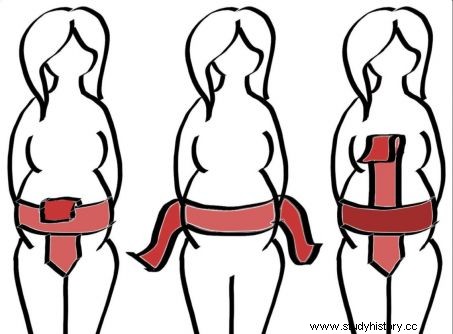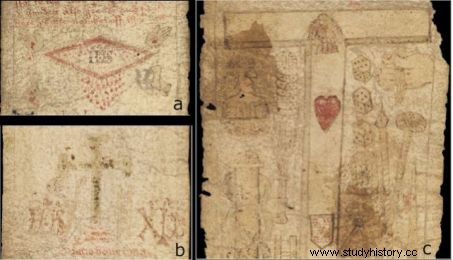Giving birth in medieval Europe was a perilous ordeal for both mother and baby. Birth belts or birth rolls made of parchment were then supposed to provide help for a safe pregnancy and childbirth. One of these manuscripts has just been analyzed.

Medieval "birth belt" dating from the 15 th century, including prayers and invocations intended to be able to give birth in complete safety.
Analysis of a 15 e "birthing belt" century made in England, constituting a precious testimony to the art of births in the Middle Ages, has just brought, with supporting biological evidence, a new light on the rituals practiced by pregnant women to protect themselves during delivery. It is a well-worn but well-preserved sheepskin parchment covered with invocations, incantatory formulas and images, including a crucifix, as detailed in a study published in the journal Royal Society Open Science .
With a width of ten centimeters and a length of more than three meters, this belt named MS 632 was, according to the researchers, wrapped around the belly to give protection to parturients like a talisman.
 Possible methods of wearing birth belts when used before, and during childbirth . ©Cambridge University / Wellcome Collection
Possible methods of wearing birth belts when used before, and during childbirth . ©Cambridge University / Wellcome Collection
Using a biomolecular analysis technique, a team of scientists was able to detect traces of honey (royal jelly proteins), milk, egg whites, leguminous plants (beans), cereals (wheat, barley , spelled). Most importantly, she found human peptides in it from vaginal fluids, evidence of the belt's actual use during childbirth, said study lead author Sarah Fiddyment of the McDonald Institute for Archaeological Research. from the University of Cambridge (UK). A first.
Childbirth was indeed a very delicate moment in the Middle Ages, the neonatal mortality rates of the mother and the child being between 30 and 60%, remind the specialists. This high number of deaths reflects the complications that could also be caused by postpartum infections. It happened regularly that the mother died a few days after childbirth as a result of puerperal fever.
This discovery provides a rare direct testimony to women's health and obstetrical care, at a time when childbirth stories were largely written by men, says one of the study's co-authors, Matthew Collins , from the University of Copenhagen (Denmark). It demonstrates the practice of rituals, combining magic and religious protection.
 Details of the "birth belt" in MS.632 parchment, with stains related to his actual use during pregnancy or childbirth. ©Cambridge University / Wellcome collection
Details of the "birth belt" in MS.632 parchment, with stains related to his actual use during pregnancy or childbirth. ©Cambridge University / Wellcome collection
Midwives then offered amulets, gems, and herbal remedies containing ingredients similar to those identified by girdle scans (milk, honey, etc.), as evidenced by descriptions in some medieval medical treatises. For noblewomen, these belts were made of silk, or snakeskin, one of which was even commissioned for the wife of King Henry VII of England (1485-1509). They could also be rented to monks, along with a host of other relics offering protection. In Westminster Abbey, the price of such a rental oscillated between "six shillings and eight pence", we note in 1502. These practices would have ended across the Channel with the English Reformation in the 16 e century. In France, the existence of sachets-accoucheurs, and parchments-amulets is also known. The potential of proteomic analyzes applied to this birthing roller also opens up a new avenue of exploration for the burgeoning field of what the Anglo-Saxons call biocodicology , the biological analysis of parchments.
B.A. with AFP
